Fig.110 shows a capacitor made of two circular plates each of radius R=12 cm and separated by 5 cm.The capacitor is being charged by an external source (not shown in the figure).Use modified Ampere's circuital law to determine magnetic field at the point P at a distance of 0.5 m from the centre of the plats in the plane midway between them,when the chargingg current is 2A?
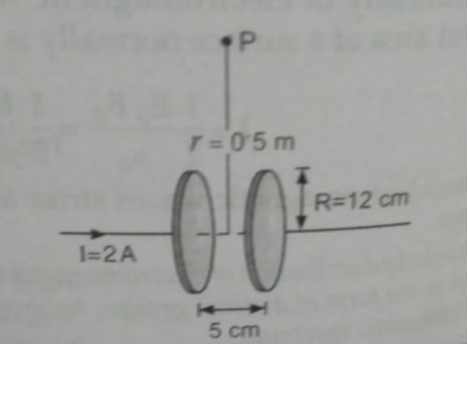 .Solution in Punjabi
.Solution in Punjabi
Step by step video & image solution for Fig.110 shows a capacitor made of two circular plates each of radius R=12 cm and separated by 5 cm.The capacitor is being charged by an external source (not shown in the figure).Use modified Ampere's circuital law to determine magnetic field at the point P at a distance of 0.5 m from the centre of the plats in the plane midway between them,when the chargingg current is 2A?. by Physics experts to help you in doubts & scoring excellent marks in Class 12 exams.
Updated on:21/07/2023Topper's Solved these Questions
- ELECTROMAGNETIC WAVESBOOK - MODERN PUBLICATIONCHAPTER - ELECTROMAGNETIC WAVESEXERCISE - EXERCISE
66 Videos
- ELECTROMAGNETIC INDUCTIONBOOK - MODERN PUBLICATIONCHAPTER - ELECTROMAGNETIC INDUCTIONEXERCISE - EXERCISE
146 Videos
- FORCE ON A CHARGEBOOK - MODERN PUBLICATIONCHAPTER - FORCE ON A CHARGEEXERCISE - EXERCISE
59 Videos
Similar Questions
Why did Maxwell introduce the concept of displacement current ?Explain.
View SolutionExplain the concept of magnetic flux linked with a surface.
View SolutionShow that the path followed by a charged particle inside the electric field is parabolic in nature.
View Solution(a) Fig shows a capacitor made of two circular plates each of radius 12cm and separated by 5.0mm. The capacitor is being charged by an external source (not shown in the figure). The charging current is constant and equal to 0.15A. Use Ampere's law (modified to include displacement current as given in the text) and the symmetryin the problem to calculate magnetic field between the plates at a point (i) on the axis (ii) 6.5 cm from the axis (iii) 15cm from the axis. (b) At what distance from the axis is the magnetic field due to displacement current greatest? Obtain the maximum value of the field.
View SolutionA capacitor made of two circular plates each of radius 12 cm and separated by 5 mm. The capacitor is being charged by an external source. The charging current is constant and equal to 0.15 A. The capacitance of the parallel plate capacitor is
View Solutionचित्र में एक संधारित्र दर्शाया गया हैं। जो 12 cm त्रिज्या की दो वृत्ताकार प्लेटों को 5.0 cm की दुरी पर रखकर बनाया गया है। संधारित्र को एक बाह्य स्रोत ( जो चित्र में नहीं दर्शाया गया है ) द्वारा आवेशित किया जा रहा है। आवेशकारी धारा नियत है और इसका मान 0.15A है।
(a) धारिता एवं प्लेटों के बीच विभवांतर परिवर्तन की दर का परिकलन कीजिए।
(b) प्लेटों के बीच विस्थापन धारा ज्ञात कीजिए।
(c ) क्या किरचाफ का प्रथम नियम संधारित्र की प्रत्येक प्लेट पर लागू होता है ? स्पष्ट कीजिए।

View SolutionThe figure shows a capacitor made of two circular plates each of radius 12 cm, and separated by 5.0 cm . The capacitor is beging charged by an external source (not shown in the figure. ) The charing is constant and equal to 0.15 A Calculate the capacitance and the rate of charge of potential difference between the plates.
View SolutionThe figure shows a capacitor made of two circular plates each of radius 12 cm, and separated by 5.0 cm . The capacitor is beging charged by an external source (not shown in the figure. ) The charing is constant and equal to 0.15 A Is Kirchhoff's first rule (junction rule) valid at each plate of the capacitor ? Explain.
View SolutionA capacitor is made of two circular plates each of radius 12 cm, and separated by 5.0 cm. The capacitor is being charged by an external source. The charging current is constant and equal to 0.15 A.
Obtain the displacement current across the plates.
View Solutionचित्र में एक समान्तर प्लेट संधारित्र (parallel plate capacitor) प्रदर्शित है|जिसकी वृताकार प्लेटों की त्रिज्या 12 cm एवं उनके मध्य दूरी 5 cm है| संधारित्र एक बाह्य स्रोत्र द्वारा आवेशित किया जा रहा है| एम्पियर के संशोधित परिपथीय नियम (modified Ampere law) का उपयोग करके प्लेटों के मध्य बिंदु से प्लेटों के मध्य से होकर गुजरने वाले 0.5 m दूरी पर स्थित बिंदु P पर चुंबकीय क्षेत्र की तीव्रता ज्ञात कीजिए, जबकि आवेशन धारा (charging current) 2A है|
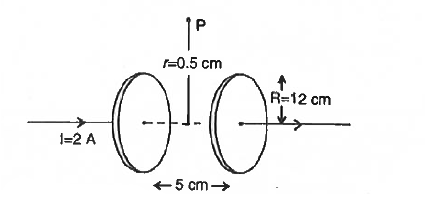
View SolutionFigure shows a capacitor made of two circular plates each of radius 12 cm, and separated by 5.0 cm. The capacitor is being charged by an external source (not shown in the figure). The charging current is constant and equal to 0.15 A. Calculate the capacitance and the rate of change of potential difference between the plates.
View SolutionFigure shows a capacitor made of two circular plates each of radius 12 cm, and separated by 5.0 cm. The capacitor is being charged by an external source (not shown in the figure). The charging current is constant and equal to 0.15 A.
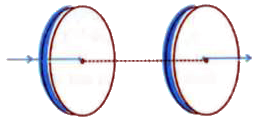
Obtain the displacement current across the plates.
View SolutionFigure shows a capacitor made of two circular plates each of radius 12 cm, and separated by 5.0 cm. The capacitor is being charged by an external source (not shown in the figure). The charging current is constant and equal to 0.15 A.
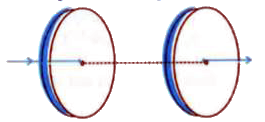
Is Kirchhoff's first rule (junction rule) valid at each plate of the capacitor ? Explain.
View SolutionA capacitor made of two circular plates each of radius 12 cm and separated by 5 cm. The capacitor is being charged by an external source. The charging current is constant and equal to 0.15 A. The capacitance of the parallel plate capacitor is
View SolutionFigure 8.6 shows a capacitor made of two circular plates each of radius 12 cm, and separated by 5.0 cm. The capacitor is being charged by an external source (not shown in the figure). The charging current is constant and equal to 0.15A. Calculate the capacitance and the rate of change of potential difference between the plates. :
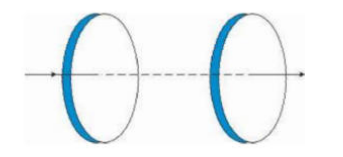
View SolutionFigure shows a capacitor made of two circular plates each of radius 12 cm, and separated by 5.0 cm. The capacitor is being charged by an external source (not shown in the figure). The charging current is constant and equal to 0.15A. Obtain the displacement current across the plates. :

View Solution
